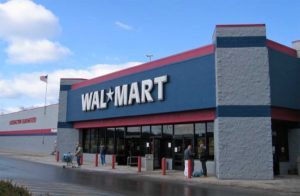
Most drone industry players working towards drone delivery can agree: those applications may be a long way off in the US, due to regulations that do not yet allow for regular flight beyond line of sight or in highly populated areas. But Walmart’s (NYSE: WMT) new patent may introduce a far more realistic application: drone delivery, indoors.
The patent, first uncovered by Fortune, describes a system of in-store drone delivery. A centralized computer system from within the store sends an order to a drone. The drone retrieves the item from the storage area within the facility, and delivers it to an in-store “delivery area.” In practical terms, a customer could walk up to a service desk, order an item, and wait in the delivery area for their item to be delivered. The size or color you wanted not on the shelves? No need to find a sales clerk; just find the computer desk and type it in. The drone would find the item in the backroom storage warehouse of the store, generally restricted to staff only, and fly through an unobstructed window in the wall that separates the warehouse from the retail area to deliver it.
The regulatory restrictions – and some of the technology bottlenecks – that limit drone delivery retail applications like Amazon’s (NASDAQ: AMZN) assume an outdoor delivery of some distance, which might require drones to fly over people’s heads or near sensitive buildings. When you bring the application indoors, those restrictions disappear, making implementation of in-store delivery a very realistic proposition.
The potential return for Walmart and other big retailers is immense. Indoor drone delivery could limit staffing requirements significantly, change the balance of space required to be presentable to the public, and significantly streamline inventory systems. The benefit to customers could be equally attractive to some: walk 20 steps into a store, place your order, and relax until it shows up.
“In a modern retail store environment, there is a need to improve the customer experience and/or convenience for the customer. Whether shopping in a large format (big box) store or smaller format (neighborhood) store, customers often require assistance that employees of the store can provide,” says the patent. “Unfortunately, there may not always be enough employees available to assist customers in as timely a manner as the customer might wish…With increasing competition from non-traditional shopping mechanisms, such as online shopping provided by e-commerce merchants and alternative store formats, it can be important for “brick and mortar” retailers to focus on improving the overall customer experience and/or convenience.”
Indoor drone delivery – with the potential to increase the bottom line in numerous ways while improving customer experience – might just be the way to do it.

Miriam McNabb is the Editor-in-Chief of DRONELIFE and CEO of JobForDrones, a professional drone services marketplace, and a fascinated observer of the emerging drone industry and the regulatory environment for drones. Miriam has penned over 3,000 articles focused on the commercial drone space and is an international speaker and recognized figure in the industry. Miriam has a degree from the University of Chicago and over 20 years of experience in high tech sales and marketing for new technologies.
For drone industry consulting or writing, Email Miriam.
TWITTER:@spaldingbarker
Subscribe to DroneLife here.







[…] beginning (they announced testing programs back in 2015.) While they have applied for patents to describe new workflows and uses for drone technology, they haven’t invested in building their own aircraft, or in […]